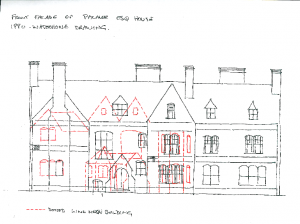Alfred Waterhouse and MERL
written by Adam Koszary, Project Officer for Our Country Lives.
Buildings are, in most cases, more famous than their architects. Exceptions are rare, such as St Pauls’s Sir Christopher Wren, or Frank Lloyd Wright (and then my limited knowledge collapses..). One architect you may not have heard of, but whose buildings you certainly will know of, is Alfred Waterhouse, who built the 19th century family home MERL now lives in.


Personally, I am not someone who usually takes notice of individual architects, but the sheer amount of buildings Waterhouse threw up around the country has meant I am often confronted by one of his piles wherever I go. While at the University of Manchester it was the gold-hued stone and red tile rooftops of Whitworth Hall and Manchester Museum which first introduced me to his work – Waterhouse, born in Liverpool, also built the similarly impressive Manchester Town Hall. Then, upon moving to London, he again confronted me with the Cruciform Building at University College, as well as his most famous and formidable creation: The Natural History Museum. I have, in fact, been following Waterhouse’s own professional journey; beginning in the North-West he then moved to London, before finally settling and retiring in Reading with his extended family, where he designed a number of buildings. The most obvious of his creations in Reading is the Town Hall, but he also constructed Old Whiteknights House and Foxhill House on the University’s Whiteknights Campus, using the latter as his own home.

East Thorpe, however, was not intended as a museum but as a family home for the prominent Reading businessman and high Sheriff of Berkshire Alfred Palmer, of the biscuit company Huntley & Palmers fame. It has gone through a couple of changes since Alfred Palmer donated the building to the University of Reading: from a Victorian Gothic Revival Town House it was converted to much-loved student Halls of Residence known as St Andrew’s Hall, and then in 2005 opened as the new home of the Museum of English Rural Life. The house has had a few additions through these changes: an extension of the building in 1962/3 and 1973/4 (see below), and the redevelopment of the gardens and construction of the main gallery for MERL in 2005.
Buildings dictate what happen within and around them through their structure and aesthetic, but they can only become significant through how we use them. As offices, the interior of East Thorpe is now fairly dull, but the exterior of the building, and particularly the internal southern part of the building, retain the grandeur of the original house. It allows MERL to tell the story of Alfred Palmer, Waterhouse and the function of a Victorian family home. We have done this through the ‘Victorian Life in the Palmer House’ activity for schoolchildren, the ever-popular MERL Victorian Family Christmas, and there is also a pop-up exhibition tomorrow focusing on the man himself and his work. The connection with Palmer also has extra significance as the vast majority of Huntley & Palmer’s archival material is held by the University’s Special Collections, to be enjoyed by the public in his very own dining room, now a reading room.

Next time you visit MERL it will be worth taking a closer look at the outside of our building and admire Waterhouse’s touches, such as the stained-glass windows, the patterned bricks or the sculptural chimneys. While we may not be as grand as the Natural History Museum, nor in fact be occupying a building even intended to be a museum, we are certainly grateful to be a part of one of England’s greatest architect’s creations.

